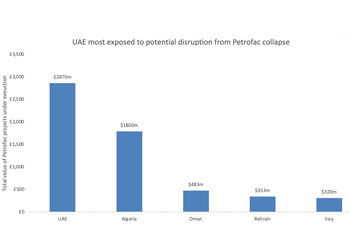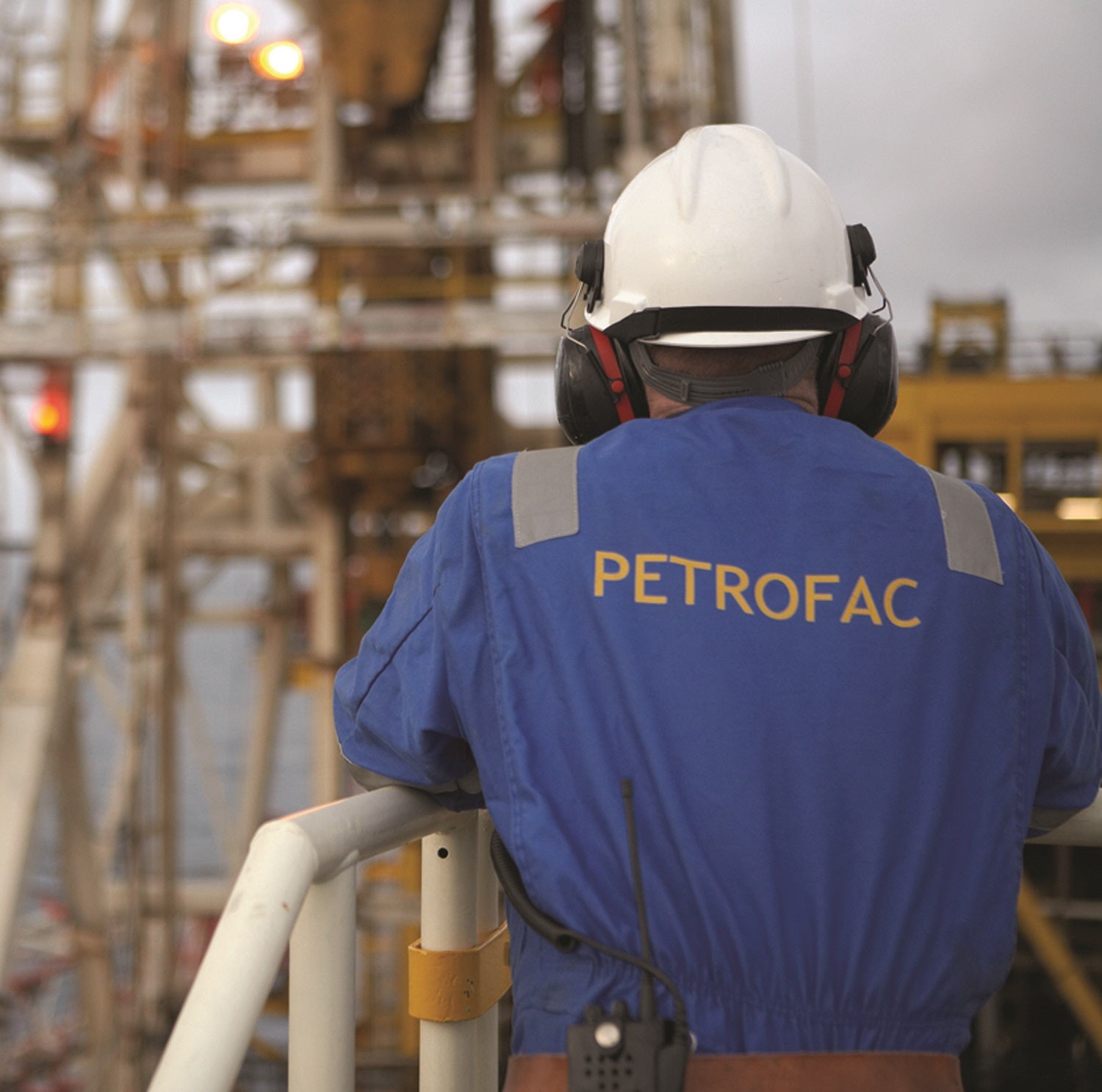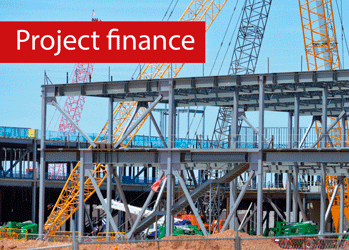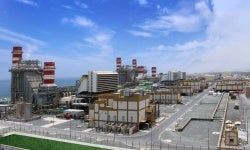Saudi Arabia sets expansionary budget for 2026
1 October 2025
Register for MEED’s 14-day trial access
Saudi Arabia’s Ministry of Finance has released its Pre-Budget Statement for the fiscal year 2026. It projects total expenditure at SR1.313tn ($349bn) in 2026 against revenues of SR1.147tn, resulting in a deficit of about SR166bn, which is about 3.3% of GDP.
The government stated that spending will continue to be expansionary and counter-cyclical, targeting national priorities with both social and economic impacts. It will also sustain economic growth and advance Vision 2030 reforms.
Medium-term projections indicate a steady increase in public finances. Revenues are expected to grow from SR1.147tn in 2026 to SR1.294tn in 2028, while expenditures are forecast to increase from SR1.313tn to SR1.419tn over the same period.
The ministry noted that accelerated programme implementation has improved financial flexibility and strengthened the kingdom’s ability to respond to economic developments.
Debt levels
Despite the projected deficit, the statement emphasised that debt levels remain within safe limits, supported by financial reserves. The government will continue to draw on multiple funding channels, including local and international bond and sukuk issuances, loans, and alternative mechanisms such as project finance and support from export credit agencies.
The ministry forecast real GDP growth of 4.6% in 2026, underpinned by gains in non-oil activities. For 2025, GDP is estimated to expand by 4.4%, with non-oil sectors expected to record 5% growth, driven by stronger domestic demand and improving labour market conditions. The unemployment rate among Saudi nationals decreased to 6.8% in the second quarter of 2025, marking a record low.
Finance Minister Mohammed Aljadaan said the 2026 budget aims to “consolidate the strength of the kingdom’s financial position, and ensure the sustainability of public finances, in parallel with supporting economic growth.” He added that priorities will continue to focus on development and social programmes, while ongoing structural reforms enhance financial and economic efficiency.
Aljadaan noted that the ratio of public debt to GDP remains low compared to other major economies, giving fiscal policy flexibility to respond to external shocks and emergency needs. He also highlighted the government’s efforts to strike a balance between the requirements of growth and sustainability.
“In light of the continued global uncertainty during 2026 and over the medium term, as a result of the possibility of continued geopolitical tensions and increasing preventive policies, the government continues to monitor and analyse these risks, as a key element in enhancing the efficiency of financial planning,” Aljadaan said.
MEED’s October 2025 special report on Saudi Arabia includes:
> COMMENT: Riyadh strives for sustainable growth
> GOVERNMENT: Riyadh confronts rising regional chaos
> ECONOMY: Riyadh looks to adjust investment approach
> BANKING: New funding sources solve Saudi liquidity challenge
> OIL & GAS: Aramco turns attention to strategic projects
> GAS: Saudi Arabia and Kuwait accelerate Dorra gas field development
> POWER: Saudi Arabia accelerates power transformation
> WATER: Transmission projects drive Saudi water sector growth
> CONSTRUCTION: Saudi construction pivots from gigaprojects to events
> TRANSPORT: Infrastructure takes centre stage in Saudi strategy
Exclusive from Meed
-
 Aldar announces new asset development plan
Aldar announces new asset development plan28 October 2025
-
 Petrofac collapse could impact $5.83bn of Mena projects
Petrofac collapse could impact $5.83bn of Mena projects28 October 2025
-
 Petrofac files for administration
Petrofac files for administration28 October 2025
-
 Region sees evolving project finance demand
Region sees evolving project finance demand27 October 2025
-
 Fujairah F3 power plant begins commercial operations
Fujairah F3 power plant begins commercial operations27 October 2025
All of this is only 1% of what MEED.com has to offer
Subscribe now and unlock all the 153,671 articles on MEED.com
- All the latest news, data, and market intelligence across MENA at your fingerprints
- First-hand updates and inside information on projects, clients and competitors that matter to you
- 20 years' archive of information, data, and news for you to access at your convenience
- Strategize to succeed and minimise risks with timely analysis of current and future market trends

Related Articles
-
 Aldar announces new asset development plan
Aldar announces new asset development plan28 October 2025
Abu Dhabi-based real estate developer Aldar Properties has announced a series of major projects across the residential, commercial and logistics sectors in Abu Dhabi, with a combined gross development value of AED3.8bn ($1bn).
In an official statement, Aldar said it will develop a new residential community in Alreeman, offering more than 2,000 rental units in the Al-Shamkha area.
Aldar will deliver 665 residential units to the rental market on Yas Island. The new developments include a gated community offering 217 units.
Aldar will also develop 448 new apartments on the island as an extension to Yas Residential Village.
On the commercial front, Aldar said it will focus on developing office space in key business districts across the UAE to meet demand for Grade A office space.
In Abu Dhabi, Aldar is currently developing Yas Business Park, an office development comprising four towers that will offer 47,500 square metres (sq m) of leasable space. The project is slated for completion in 2027.
In the logistics sector, Aldar said it is developing high-quality warehousing and distribution space across the UAE. Aldar added that it will expand the Abu Dhabi Business Hub by adding 175,000 sq m of gross floor area to the Musaffah site.
Aldar will also deliver Abu Dhabi’s first Tesla Experience Centre on Yas Island. The facility will span 5,000 sq m and will include a showroom, service centre and delivery operations.
“Upon completion, the new residential, commercial and logistics assets will become part of Aldar Investment’s portfolio, which comprises income-generating real estate valued at AED47bn,” Aldar said in its statement.
https://image.digitalinsightresearch.in/uploads/NewsArticle/14960800/main.gif -
 Petrofac collapse could impact $5.83bn of Mena projects
Petrofac collapse could impact $5.83bn of Mena projects28 October 2025

On 27 October, Petrofac announced that it had applied to appoint administrators, a move that has potentially put thousands of jobs at risk and increased uncertainty for projects worth billions of dollars in the Middle East and North Africa (Mena) region.
The total value of projects awarded to Petrofac and under construction in the region is $5.83bn, according to information recorded by the regional project-tracking service MEED Projects.
Petrofac also has bids under evaluation for 15 projects in the region worth a total of $19.28bn, according to MEED Projects data.
Over recent years, Petrofac has aggressively sought to win new contracts in the Mena region, bidding on a range of projects in an effort to improve its financial situation.
Some of the tender processes in which Petrofac is currently participating could ultimately be disrupted due to the company’s financial problems, especially when there is only one other bidder for the contract.
Regional impact
The UAE is potentially the most exposed to disruption from Petrofac filing for administration. It is executing major projects worth $2.87bn in the UAE.
Algeria is second in the region in terms of exposure to contracts under execution, with $1.8bn in projects.
Petrofac also has projects in Oman, Bahrain and Iraq, worth $483m, $353m and $320m, respectively.
UAE projects under execution
In the UAE, Petrofac has five active projects, all awarded by Abu Dhabi’s state-owned Adnoc Gas.
The biggest of these is a $1.2bn project for the planned Das Island gas liquefaction facility, which was awarded in June this year and expected to be completed by the fourth quarter of 2027.
The second-biggest contract that Petrofac has in the UAE is a $700m contract as part of Adnoc Gas’ project to upgrade its sales gas pipeline network across the UAE.
The scope of the package is focused on developing a new compressor plant at the Habshan gas compressor facility.
This contract was awarded in June 2023 and was previously expected to be completed before the end of next year.
The other significant contracts that Petrofac has in the UAE include a $615m contract for a carbon capture, utilisation and storage (CCUS) facility at the Habshan site, as well as a $335m contract to upgrade the Habshan gas processing complex.
Adnoc Gas awarded the CCUS contract in October 2023, and the upgrade contract was awarded in January this year.
In addition to the projects Petrofac has won in the UAE, it has bids currently under evaluation worth $6.6bn in the country.
Petrofac in Algeria
Petrofac’s largest ongoing project in the Mena region is the $1.5bn project that it is executing to develop a major petrochemicals project in Algeria.
The Scotland-based company is executing the project in partnership with China Huanqiu Contracting & Engineering Corporation (HQCEC) in Algeria’s Arzew region.
Petrofac and HQCEC signed the engineering, procurement and construction (EPC) contract for the Algerian petrochemicals project in June 2023.
HQCEC is a subsidiary of China National Petroleum Corporation.
In July 2024, MEED reported that concerns about the project’s future were increasing due to Petrofac’s financial difficulties.
The project is being developed in the Arzew Industrial Zone, west of Algiers, and the contract was signed with STEP Polymers, a wholly owned subsidiary of Algeria’s national oil company, Sonatrach.
When the contract was signed, Petrofac said that its portion of the project was valued at about $1bn.
The project’s scope includes the design and construction of two major integrated processing units.
It includes the delivery of a new propane dehydrogenation unit and polypropylene production unit, as well as associated utilities and infrastructure for the site.
It is expected to produce 550,000 tonnes of polypropylene a year.
Petrofac has been active in Algeria since 1997, when it opened its first office in Algiers. The company has since developed some of the country’s most significant oil and gas assets.
On top of the projects under execution in Algeria, Petrofac has bids under evaluation for projects worth $7.19bn in the country.
Petrofac in Oman, Bahrain and Iraq
Petrofac is working on a range of strategic upstream projects across Oman, Bahrain and Iraq.
These contracts include a $370m project to expand the central processing facility (CPF) at Iraq’s Majnoon field.
In August this year, MEED reported that Petrofac was pushing to complete the project contract.
The EPC contract for the project was awarded to Petrofac by Basra Oil Company (BOC) in 2018.
Originally, the contract had a 34-month time period, but, like many other projects awarded at a similar time, the project was delayed due to complications related to the Covid-19 pandemic.
In August, MEED reported that the final part of the project that needed to be addressed was an issue relating to a single unit of the expansion project.
The oil processing trains were mechanically complete in October 2022 and were ready for startup in late 2023.
The facility then started operating in 2024. However, due to issues related to product specifications, it was taken offline.
Majnoon is Iraq’s fourth-biggest oil field and is estimated to contain 12.6 billion barrels of oil.
Petrofac does not currently have any bids under evaluation in Iraq or Oman, but it has submitted bids for projects worth $900m in Bahrain.
Over recent years, Petrofac has been attempting to expand in Kuwait, Saudi Arabia and Libya.
In these countries, it currently has bids under evaluation for projects worth a total of $4.63bn.
https://image.digitalinsightresearch.in/uploads/NewsArticle/14960597/main5727.gif -
 Petrofac files for administration
Petrofac files for administration28 October 2025
The UK-based engineering company Petrofac, which is active across much of the Middle East and North Africa (Mena) region, has filed for administration amid escalating financial challenges.
In a statement, the company said that its directors had “applied to the High Court of England and Wales to appoint administrators”.
The statement added: “This is a targeted administration of the group’s ultimate holding company only.”
Petrofac is actively working on projects in the UAE, Algeria, Kuwait and Bahrain. Projects in the UAE include an engineering, procurement and construction management contract awarded by Adnoc Gas in June.
The company’s collapse followed the termination of an offshore electricity transmission contract by Netherlands-based TenneT, derailing a restructuring plan.
The group’s operations will continue to trade, and options for alternative restructuring, as well as potential solutions such as mergers or acquisitions, are being explored, the company said.
It added: “When appointed, administrators will work alongside executive management to preserve value, operational capability and ongoing delivery across the group’s operating and trading entities.”
Petrofac has suffered from high debt levels for several years and was negatively impacted by shutdowns during the Covid-19 pandemic.
Its financial problems led to the suspension of its shares from the London Stock Exchange in May.
https://image.digitalinsightresearch.in/uploads/NewsArticle/14960595/main.jpg -
 Region sees evolving project finance demand
Region sees evolving project finance demand27 October 2025

The GCC remains in the grip of an infrastructure supercycle that requires project sponsors to seek out the most efficient funding solutions. This places project finance firmly in the frame, with interest piqued by developers’ preference for financing models that match long-term concessions with long-term debt.
Deal advisers note the buoyancy of the Gulf projects market.
“There is a collective appreciation for international capital and international resources and skills that is creating healthy competition in the region, which has not been seen before. This is fuelling some of the project finance boom,” says Andrej Kormuth, head of law firm Bracewell’s Middle East projects practice.
Deferring costs
Non-recourse lending – in which lenders rely on a project’s cash flow – remains a popular method of deferring costs in the Middle East, and one that has grown in volume and size. The availability of long-term offtake agreements with creditworthy counterparties has helped to reinforce investor confidence.
“Gulf states have recognised the budgetary benefit of not having to pay for infrastructure up front or in short order, but rather deferring these costs over a period of time – allowing a bit more budgetary flexibility in relation to critical spending,” says Kormuth.
GCC governments have seen project financing deliver value over the long term, helping them as they map out their long-term economic transformation programmes.
“The procurers have seen how well the project finance deals in the Gulf have been run. They have seen the benefit of having international skills come in that would not historically have been locally available, and of running these assets for the long term,” says Kormuth.

Shifting asset classes
While traditional sectors such as power continue to dominate – according to ratings agency S&P Global, utilities alone accounted for 75% of project finance loans over the past five years – new sectors have come to the fore that are suitable candidates for project finance, including battery storage.
“Over the last 12-18 months, one of the new developments has been the introduction of the new asset class of battery storage projects in jurisdictions such as Abu Dhabi and Saudi Arabia,” says Oliver Irwin, head of project finance at Bracewell.
“These projects are being developed on a very large scale, which gives rise to new challenges from a financing perspective, in terms of considerations for things like split procurement and battery degradation, which are not necessarily features of wind and solar project financings.”
Alongside the almost 90GW of renewable energy that Saudi Arabia will install over the next five years, the kingdom is also planning 48 gigawatt-hours of storage battery capacity by 2030.
There has also been a significant refocusing on the mining sector and digital infrastructure in the region, according to Munib Hussain, a partner at Milbank LLP, a project finance specialist.
“Mining [is seeing increased interest] because of factors such as the energy transition, and the rush to try and secure the minerals that support the energy transition, and as another means of diversifying economies. There is a real drive in the GCC at the moment to try and build out the midstream processing infrastructure for those critical minerals.”
These projects are proving highly adaptable for non-recourse lending structures, backed by the preferred model of a long-term contract with a single offtaker.
Data centres are another area of growth where project finance is likely to make a mark in the GCC, though this may require a steeper learning curve for lenders.
“In the digital space, there are still some challenges to [closing] large-scale project financing,” says Hussain. “But we know there are hyperscalers that are expected to come in with slightly longer-term leases or MSAs [master service agreements] that can support a project financing.”
These may have tenors of around 10-15 years, which Hussain points out is not particularly common, but he says the hyperscalers “see the opportunity to have a foothold there – and so they may be committing for slightly longer tenors”.
While renewable energy and data centres present new avenues for project lending, advisers point out that the Gulf has a surfeit of conventional infrastructure projects that are in need of funding – gas-fired independent power projects, for example, have seen a revival, as have water desalination and water reservoir storage projects.
Ancillary infrastructure around Saudi Arabia’s gigaprojects is also keeping lenders busy. Saudi Power Procurement Company plans to add about 7GW of combined-cycle gas turbine capacity annually over the next five years.
“The energy sector is quite buoyant,” says Bracewell’s Kormuth. “Two years ago, it was almost entirely dominated by renewables. Now, we are seeing quite a significant shift towards conventional, gas-fired baseload power stations.”

International re-entry
In newer sectors such as battery storage, international banks have built up their experience levels and are looking to replicate that in the GCC.
“A lot of the international banks that are supporting the new wave of battery storage projects in the region have experience of financing battery projects in Europe and elsewhere.
“So, while it might be new for the region, it is not necessarily new for those banks,” says Bracewell’s Irwin.
The re-entry of international lenders has changed the pricing equation, too.
“The international commercial banks have become even more competitive, coming into domestic GCC projects, often outpricing the regional banks, which was not the case for the last five years or so,” says Hussain.
Whereas regional banks used to be much more competitive than international banks, various liquidity constraints have meant that the international banks are now coming in at much tighter pricing than ever before.
So, while recent years have witnessed much liquidity and risk appetite from the local and regional banks that have started to play a prominent role in the financing of major infrastructure and energy projects, Bracewell’s Irwin says that in the last 12 months, there has been “a resurgence of sorts from the traditional international banks, leading to Middle East project deals, in particular in Saudi renewables projects”.
New sectors have come to the fore that are suitable candidates for project finance, including battery storage
Financing structures
Refinancing has been a feature of GCC project financing arrangements for many years. The so-called soft mini-perm structure, which involves margin step-ups and cash sweeps that give an incentive to refinance debt over time, retains popularity among sponsors.
 “The primary and preferred method for project financings in the region is a soft mini-perm. It is a proven model that works very well for the region and continues to attract a deep pool of financiers that are willing to lend to the region’s large pipeline of energy and infrastructure projects,” says Irwin.
“The primary and preferred method for project financings in the region is a soft mini-perm. It is a proven model that works very well for the region and continues to attract a deep pool of financiers that are willing to lend to the region’s large pipeline of energy and infrastructure projects,” says Irwin.Export credit agency (ECA) and Islamic tranches remain prominent features of project loans, sometimes in combination. This was the case with UK Export Finance’s guaranteeing of a $700m Islamic Murabaha financing facility to finance the construction of the Six Flags Qiddiya City theme park in Saudi Arabia.
“We continue to see that Islamic financing is a key tool for project sponsors. If you are looking to diversify your funding base, it is now very normal to have an Islamic finance tranche alongside a conventional tranche, as well as an ECA tranche,” notes Irwin.
Capital market instruments are another innovation identified by Gulf deal advisers. Saudi Arabia’s Greensaif pipeline transaction with BlackRock and Saudi Aramco in 2024 was a pipeline monetisation deal that saw BlackRock take a 49% interest in Aramco’s gas pipelines in Saudi Arabia.
“There was a $13.4bn acquisition/stapled financing associated with that, which needed to be refinanced within a certain period of time,” says Hussain.
BlackRock went to various funding sources, including the conventional bank market, the international bond market and the sukuk (Islamic bond) market.
“The bonds and sukuk issued in connection with Greensaif are project bonds, because underlying the payment of the coupon on both was the revenue from the underlying project contracts with Saudi Aramco. These issuances were some of the largest project bonds issued in the region in recent times,” says Hussain.
The Gulf’s pull for project financiers shows no signs of petering out. Lenders have developed a taste for regional risk, and international banks are particularly keen to get back in the game. The mood music is positive.
“We have seen that different types of banks get priced out of the market from time to time, but they invariably look to return to the market because Middle Eastern projects are generally well-structured financings with very robust revenue streams. That gives rise to a lot of enthusiasm to support these projects,” says Irwin.
https://image.digitalinsightresearch.in/uploads/NewsArticle/14955586/main.gif -
 Fujairah F3 power plant begins commercial operations
Fujairah F3 power plant begins commercial operations27 October 2025
State offtaker Emirates Water & Electricity Company (EWEC) and project partners have announced the start of full commercial operations at the 2.4GW Fujairah F3 independent power producer project.
Located in Qidfa, the $1.14bn Fujairah F3 project is the UAE’s largest natural gas-fired combined-cycle power plant.
Developed between the existing Fujairah F1 and F2 facilities, the plant can supply electricity to about 380,000 homes. Ewec is the sole procurer of electricity from the project under a long-term power purchase agreement.
Fujairah Power Company F3, a special purpose company, is developing the project.
It is jointly owned by Abu Dhabi National Energy Company (Taqa, 40%), Japanese firms Marubeni Corporation (20.4%) and Hokuriku Electric Power Company (19.6%), and the UAE’s Mubadala Investment Company (20%).
Financial close was reached in mid-2020 through a consortium of international lenders, including Japan Bank for International Cooperation, Mizuho Bank (Japan), Sumitomo Mitsui Banking Corporation (Japan), BNP Paribas (France) and Standard Chartered (UK).
South Korea’s Samsung C&T was awarded the engineering, procurement and construction contract, while engineering consultancy was provided by Austria’s ILF Consulting and Germany’s Fichtner Consulting.
The facility is equipped with three Mitsubishi Power M701 JAC gas turbines, each weighing more than 500 tonnes, integrated with heat recovery steam generators.
Mitsubishi Power was operating under the name Mitsubishi Hitachi Power Systems at the time of the contract award, before Hitachi exited the joint venture in 2021.
Construction of Fujairah F3 was completed in late 2024.
https://image.digitalinsightresearch.in/uploads/NewsArticle/14953479/main.jpg



